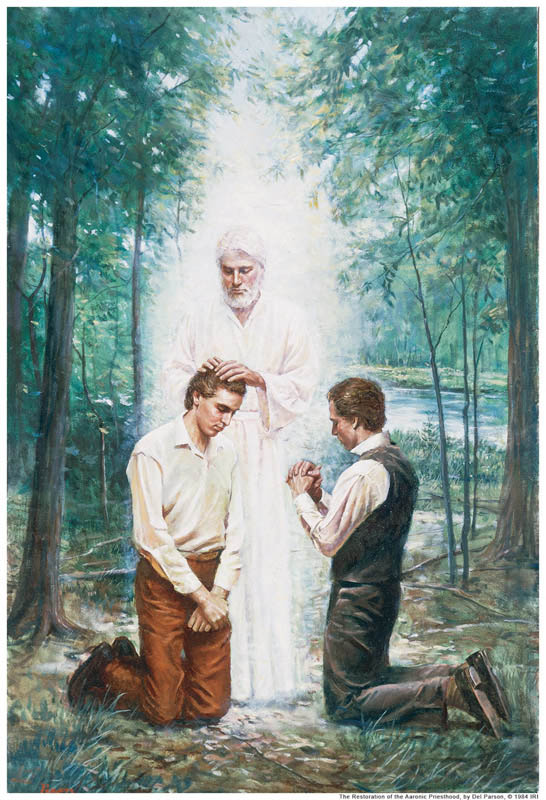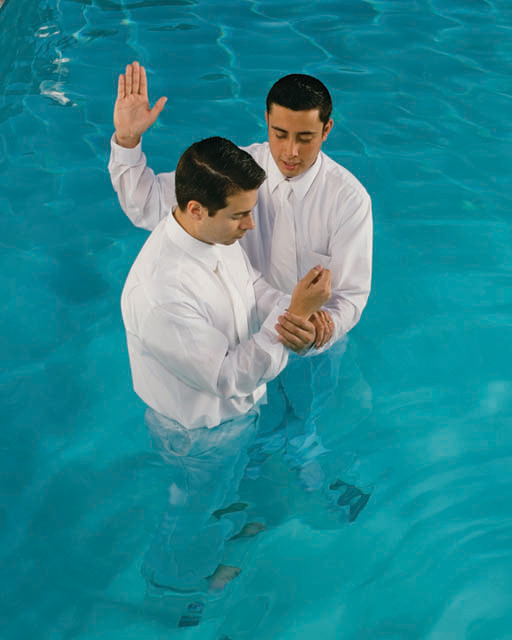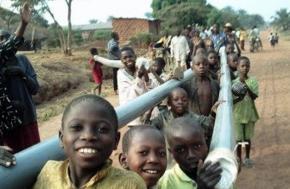A
 Aaronic Priesthood: The first level of the lay priesthood. Men and boys may receive the Aaronic Priesthood beginning at age twelve. It consists of three levels: deacon, teacher, and priest. Holders of this priesthood are able to participate in some of the special ordinances of the church and to serve others.
Aaronic Priesthood: The first level of the lay priesthood. Men and boys may receive the Aaronic Priesthood beginning at age twelve. It consists of three levels: deacon, teacher, and priest. Holders of this priesthood are able to participate in some of the special ordinances of the church and to serve others.
Abortion: The stance of the Mormon Church is that abortion is next to murder. It may be practiced only in cases of rape, incest, or imminent danger to the mother, and then only after prayer and counseling with church leaders.
Active: An active Mormon is a member in good standing who regularly attends church, accepts church assignments, and strives to keep the commandments.
Activity Days: A weeknight meeting for girls ages eight to eleven. The girls work to achieve goals, master practical life skills, and develop their faith under the direction of an adult leader.
Adam: The first man. The head of all dispensations, under the governance of Christ. Latter-day Saints do not worship Adam or believe he was God.
Age of accountability: The age at which a person is old enough to understand right and wrong and to be held responsible for choices they make. This occurs at the age of eight, and therefore is the earliest age at which a child may choose to be baptized.
Agency: Our God-given right to choose, even when our choices hurt us. We had this right before we were born and it is critical to our purpose on earth and our ability to freely choose to follow the Savior’s path and teachings.
Angels: Mormons believe in angels and that they are constantly ministering to the needs of men on earth. They are mostly resurrected beings with assigned stewardship over and interest in the activities of all who live on earth. Under the direction of Christ, they are instructed to teach and pass on their authority to men from time to time. Thus, men who have had important roles in God’s kingdom on earth act as angels in governing the dispensations on earth. Adam is the archangel Michael; Noah is the archangel Gabriel (Teachings of the Prophet Joseph Smith, 157). There are also angels who attend us personally.
Apostle: One of fifteen LDS church leaders chosen to serve as special witnesses of Jesus Christ, as were the apostles who served with Jesus Christ during His earthly ministry. These apostles include the prophet, his two counselors, and the Quorum of the Twelve Apostles.
Apostasy, the: After the death of the Savior and His apostles, there was no one with authority to receive revelation for the church. Without an authorized priesthood or prophets, doctrines were debated and changed. The world fell into a state of general apostasy until Joseph Smith was called to participate in the promised restoration.
Apostasy, Personal: When a person turns away from God’s teachings and from His Church despite having had a testimony of its truthfulness.
Articles of Faith: Thirteen statements of basic beliefs of Mormons, written by Joseph Smith at the request of a newspaper publisher.
Atonement: Paying the price for sins, so the sinner can return to God. Jesus Christ atoned for our sins in the Garden of Gethsemane and on the cross. He was the only person who was able to do this, due to His dual parentage of a mortal mother, Mary, and God the Father. The atonement freed us from the sin of Adam, guaranteed resurrection for all, and provided us a way to receive exaltation as we repent of our sins.
Auxiliaries: Organizations within the Mormon Church that educate the members and assist them in living the gospel. There are organizations for every member over the age of eighteen months.
B
 Baptism by fire: Mormons are baptized by immersion. Following this, they receive the gift of the Holy Ghost, which is referred to as baptism by fire (as opposed to water.) The Holy Ghost is conferred through a special blessing given by priesthood holders who place their hands on the person’s head.
Baptism by fire: Mormons are baptized by immersion. Following this, they receive the gift of the Holy Ghost, which is referred to as baptism by fire (as opposed to water.) The Holy Ghost is conferred through a special blessing given by priesthood holders who place their hands on the person’s head.
Baptism by immersion: The method used to baptize Jesus, who was lowered entirely under water. Mormons today are baptized in the same way to provide a remission from sin. Immersion symbolizes burial and then rebirth as a new person.
Baptism for the dead: Baptism by proxy. Teenagers and adults can be baptized in the temple on behalf of ancestors who have died. This does not automatically make the person represented a Mormon. It only offers him the opportunity, as he abides in the Spirit World, to accept the gospel if he chooses. If he declines, it is as if the baptism never occurred. Jesus taught that baptism is mandatory for admission to God’s presence, and baptism for the dead prevents a person from being unfairly excluded from God’s presence, if he had no opportunity to receive the gospel in his lifetime.
Battle of Armageddon: A future gathering of armies whose aim it is to destroy Israel. The center of the battle will be in the Valley of Megiddo, about 60 miles north of Jerusalem. Latter-day Saints believe in the prophecies revealed in the Book of Revelation.
Bearing testimony: Sharing one’s faith in Jesus Christ and in God. The first Sunday of each month, a church service is devoted to giving this opportunity to those who desire it, but members are encouraged to share their testimonies with others throughout their daily life.
Beehive: A popular symbol in Mormon pioneer days to represent hard work and cooperation. Today, it is the name given to the youth program for girls ages twelve and thirteen.
Belief: The scriptures consistently use belief as a synonym for faith. No one has faith in Christ who does not believe that He is the Son of God (Mormon Doctrine). However, belief is also understood to mean something that falls short of faith. There are many who hear the gospel and believe it, yet cannot seem to devote themselves to living according to the commandments of God.
Bible: English-speaking Mormons generally use the King James Version of the Bible. Mormons are Bible-believing Christians. Joseph Smith was working on a translation of the Bible. His translation of Matthew is contained in the Pearl of Great Price, a book of LDS scripture. Other verses are included as footnotes in the KJV printed by the Church. No changes have been made to the original King James by the Church, but its printed edition is cross-referenced to other LDS scriptures.
Birth Control: The Church’s stand on birth control is that it is the business of husband and wife to counsel with the Lord as to when and how to bring children into the world. Church leaders counsel us not to put off having children or to limit family size out of selfishly material considerations.
Bishop: The lay leader of a Mormon congregation. Similar to the role of a pastor or rabbi, but is done without pay and while simultaneously carrying out one’s career and family life. The bishop is always a male who holds the Melchizedek priesthood, unless he is a literal descendant of Aaron. He has two counselors to assist him.
Bishopric: A bishop and his two counselors, plus the clerks who oversee finances and record-keeping.
Bishop’s Court: Bishops are judges in Israel, and when sin is committed, members confess to their bishops. When some sort of disciplinary action must be considered, the transgressor may sit before the bishop and his two counselors in a “bishop’s court.” The purpose of the court is not to be vindictive or harsh, but to help the person through the process of repentance.
Blessing: A gift from God. The word “blessing” is also used to denote a special gift conferred by a member of the priesthood, who places his hands on the head of a person and offers a prayer of healing, comfort, or guidance given through inspiration from God.
Blessing of Children: Shortly after a baby is born, the child is given a “name and a blessing” by the elders of the Church. This is very similar to the Jewish “brit mila,” except that circumcisions are never performed. The rite can be held in the family home, but is normally held during a sacrament meeting at church.
Blood Atonement: The Church of Jesus Christ of Latter-day Saints has never practiced what critics call “blood atonement,” wherein transgressors forfeit their lives to pay for serious sin. Mormons believe that Christ died on the cross for our sins, performing blood atonement in our behalf.
Book of Abraham: A book in the Pearl of Great Price, translated partly from ancient Egyptian papyri and partly by revelation to the Prophet Joseph Smith. In it we learn about pre-mortal life, fore-ordination, and more of Abraham’s history.
Book of Commandments: The original title of the Doctrine and Covenants.
Book of Enoch: Referred to in Doctrine and Covenants, Section 107, the Book of Enoch is a book of scripture yet to come forth. The record contains the prophecies of Adam, when he “predicted whatsoever should befall his posterity unto the latest generation.” The Pearl of Great Price contains some information about Enoch, and Paul’s writings indicate that he had information about Enoch not contained in the Old Testament.
Book of Life: 1) The record of the acts of men, written in their own bodies. 2) In a literal sense, the Lamb’s Book of Life, or the record kept in heaven which contains the names of the faithful and an account of their righteous deeds and covenants.
BOM: A written abbreviation for Book of Mormon.
Book of Mormon: A scriptural record of some of the Israelite inhabitants of the ancient Americas, a second witness for Jesus Christ. The record covers a time period of 600 B.C. to 400 AD. It records the visit of the resurrected Jesus Christ, His teachings, and His organization of His Church among the people.
Born Again: To gain salvation and exaltation, men and women must be born again. This means to be born of water and the spirit so as to be changed from their carnal state to a state of purity and righteousness, becoming spiritually begotten of God.
Branch: A congregation that is smaller than the typical size. It is presided over by a branch president and two counselors, rather than a bishop and counselors.
Brass Plates: The Book of Mormon begins with the story of Lehi, a Jerusalem prophet who escaped destruction in 600 B.C. with his family. The family took with them to the Americas scriptures engraved on brass plates, which included a record of the Jews and the genealogy of Lehi’s lineage.
Brother: Refers to Mormon men. Members address male church members by the title of Brother, followed by the surname [Brother Jones, for example]. In the Church, the plural is “brethren.” It reminds us we are all children of our Heavenly Father, and therefore are brothers and sisters. Women are addressed as “Sister.”
Brother of Jared: The main branch of the Book of Mormon people found a more ancient civilization which had destroyed itself. They found a record of the Brother of Jared, Mahonri Moriancumer, who was so faithful, he had seen the pre-existent Christ, who should come into the world to save mankind.




